
May 6
/
Victor Arduin
Macroeconomics Weekly Report - 20240510
Back to main blog page
Will the Fed raise interest rates in the US?
- Price growth persists into 2024, frustrating the market's most optimistic expectations, which,at the end of 2023, predicted a possible interest rate cut in the first half of this year.
- Non-farm payroll came in below market estimates last month, momentarily dispelling speculation about the need for the Fed to raise interest rates to curb inflation.
- One of the consequences of this scenario of growing risk aversion is the appreciation of US Treasury bonds, boosting the dollar and creating a bearish environment for commodities.
Introduction
The market's initial optimism about US interest rate cuts at the end of 2023 has given way to a more cautious outlook. Economic indicators, while poiting to an improvement in inflation, suggest that convergence towards the 2% target will be more gradual than previously anticipated.
This scenario presents challenges for the commodities markets. The appreciation of the dollar, driven by economic numbers in the United States, makes assets traded in the American currency more expensive. Not only are borrowing costs expected to remain high for longer, but there is also the speculation of a further increase in interest rates, currently in the 5.25%-5.50% range, will rise further.
The Federal Open Market Committee (FOMC) continues to stress that the conduct of monetary policy is conditional on economic indicators converging to more favorable levels. With this in mind, in this report we will discuss some of the country's main economic indicators and their influence on maintaining interest rates in the country.
Image 1: US - Inflation (%)
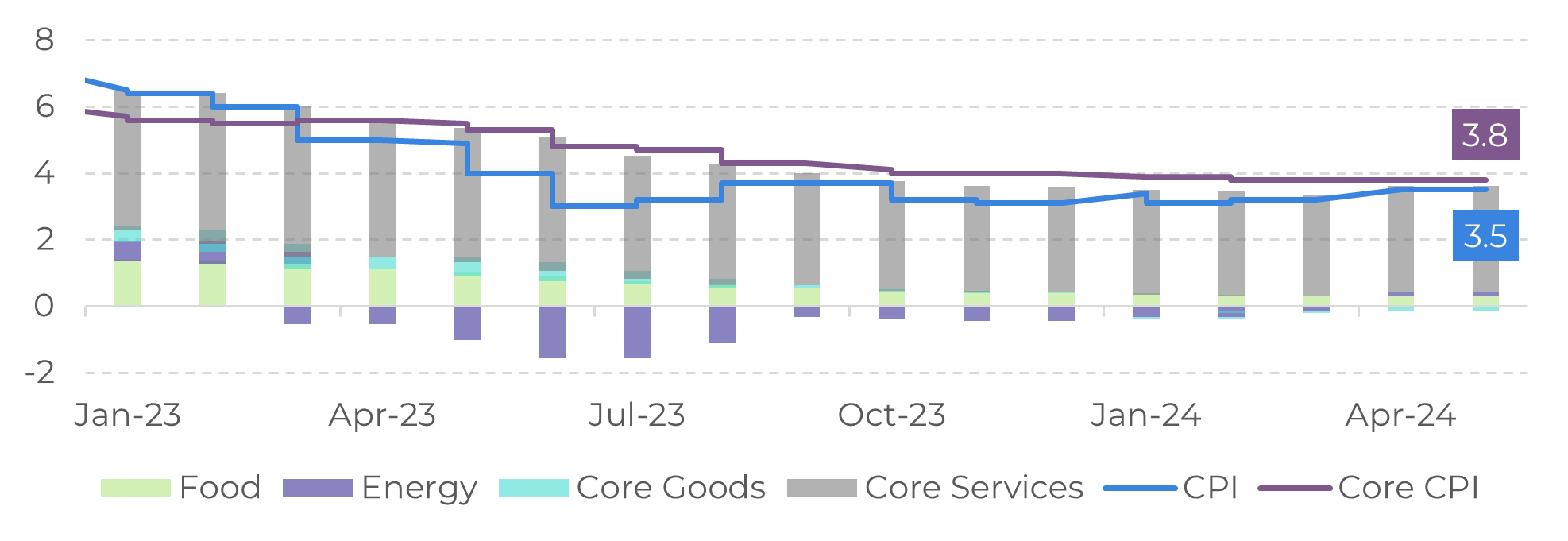
Source: Bureau of Labor Statistics
Image 2: US - Non-farm Payrolls
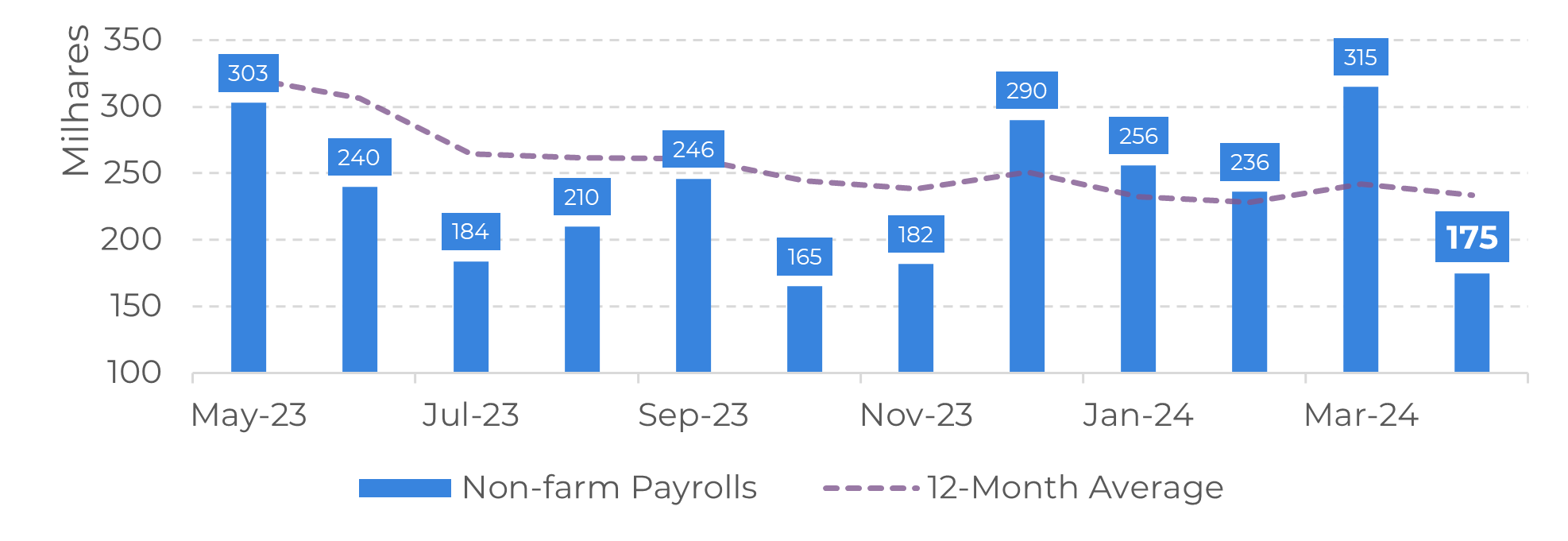
Source: Bureau of Labor Statistics
Labor market eases inflationary pressures
For the time being, last week's data on the US labor market brought some relief regarding the need for further interest rate hikes in 2024. Non-farm payroll came at 175,000 against a market forecast of 243,000. The unemployment rate rose slightly to 3.9% (+0.1%). In addition, wage growth slowed down from 4.1% to 3.9%.
On the other hand, despite the slowdown, the country's economic performance remains resilient, especially with retail sales figures showing robust growth in March (+0.7%). This result, combined with upward revisions to the US GDP, raises some concerns and contributes to the Fed's difficulties in containing inflation and reaching its 2% target.
Considering that a significant portion of GDP is made up of household spending, which is directly related to the purchasing power of wages (real earnings), it is clear that there is still a scenario of inflationary pressure that will make it difficult to overcome the "last mile" in the fight against inflation in the coming months.
Image 3: US – Monthly Retail Sales (%)
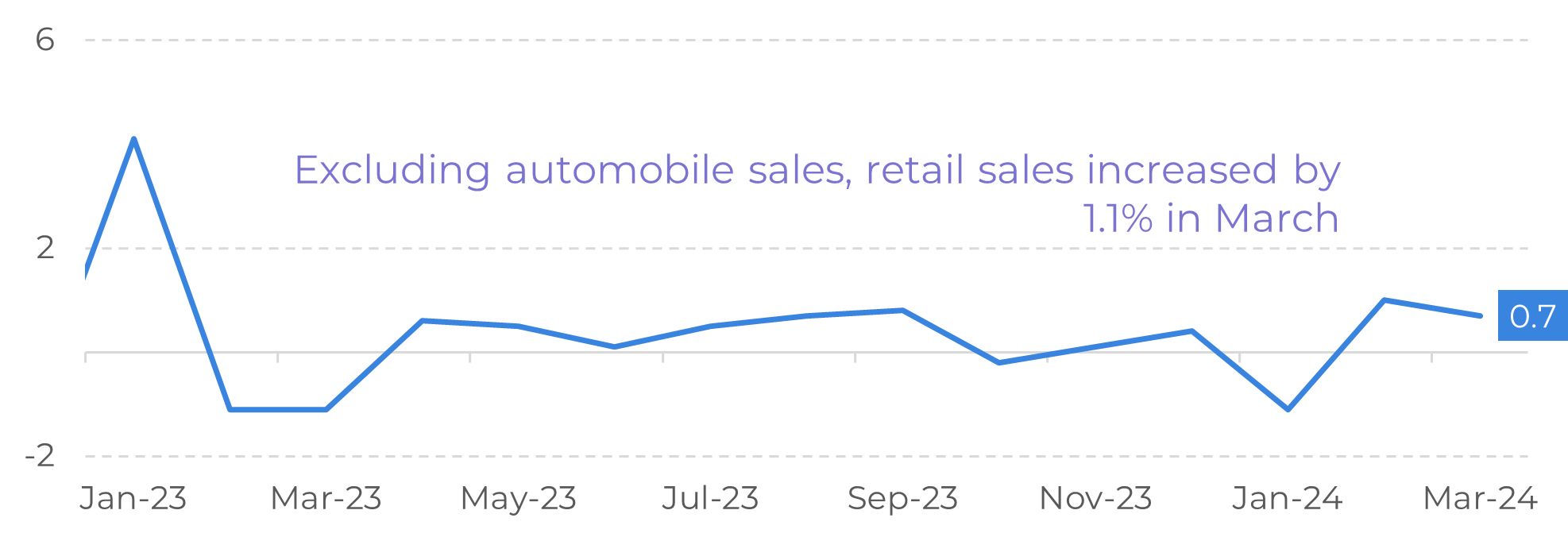
Source: Refinitiv
There are still no conditions for an interest rate cut
The persistence of high inflation in the United States, as measured by both the CPI index and the PCE, reinforces the scenario of risk aversion among investors, boosting yields on US Treasury bonds and raising the risk of a recession, although this risk is still considered low.
Inflation has been exceeding expectations throughout 2024, which significantly reduces the chances of an interest rate cut. At the end of 2023, the market was discussing the possibility of interest rate cuts in the first half of 2024. Now, with high inflation persisting, speculation is swirling around the possibility of a further increase.
However, the impact of current interest rates on the slowdown in the economy will become clearer as new data becomes available, such as the latest labor market figures. It is unlikely that the Fed will further intensify the policy of restrictive interest rates, at the risk of pushing the country into recession. According to the "soft landing" scenario projected by the US central bank, there is room for two cuts of 25 basis points in the interest rate from September until the end of this year.
Image 4: US - Treasury Yields (%)
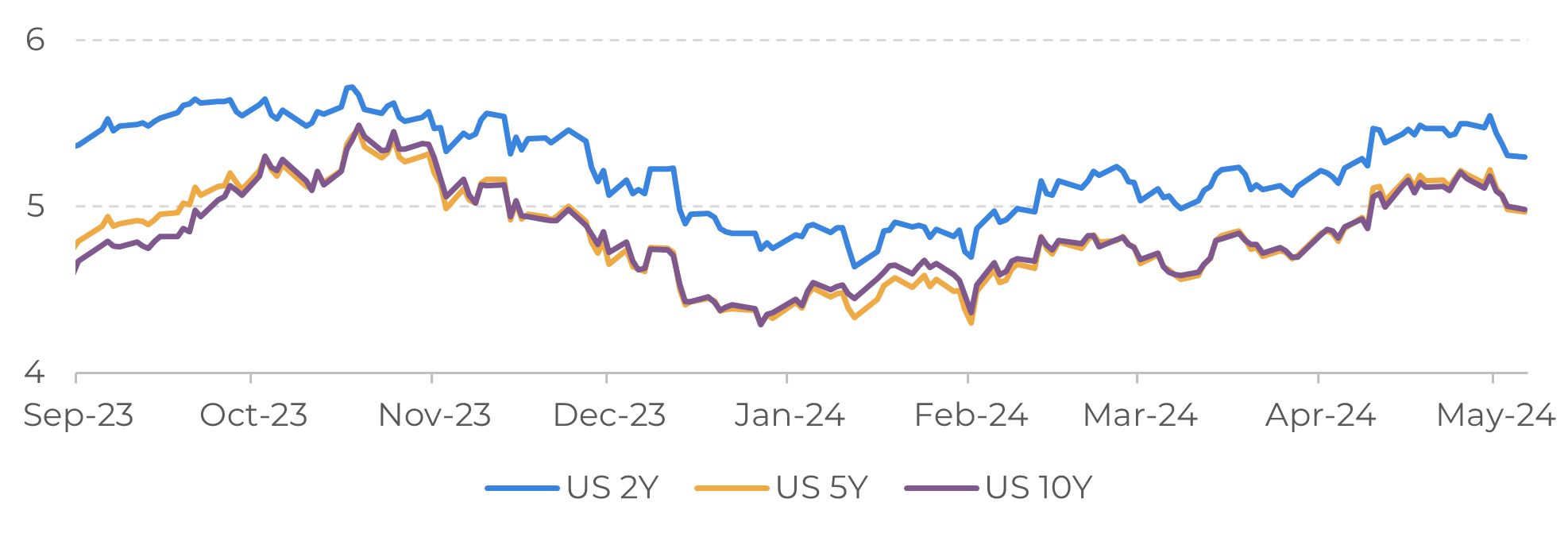
Source: Refinitiv
In Summary
Knowing when interest rates will start to fall can be an important indicator for the commodities market, as it can signal a reversal in the appreciation of the dollar, impacting demand and the valuation of assets.
In recent weeks we've seen a series of bullish data on inflation in the United States, resulting in a rise in risk aversion and speculation about an increase in interest rates.
The persistence of higher than expected inflation does not invalidate the effectiveness of the restrictive monetary policy in combating inflation. There has been a gradual improvement in recent months, which will tend to strengthen in the future as new data becomes available.
In the current scenario, we expect the long-awaited US interest rate cut to take place from September, ending the year with two cuts of 25 basis points.
Image 5: General Consumer Confidence Index
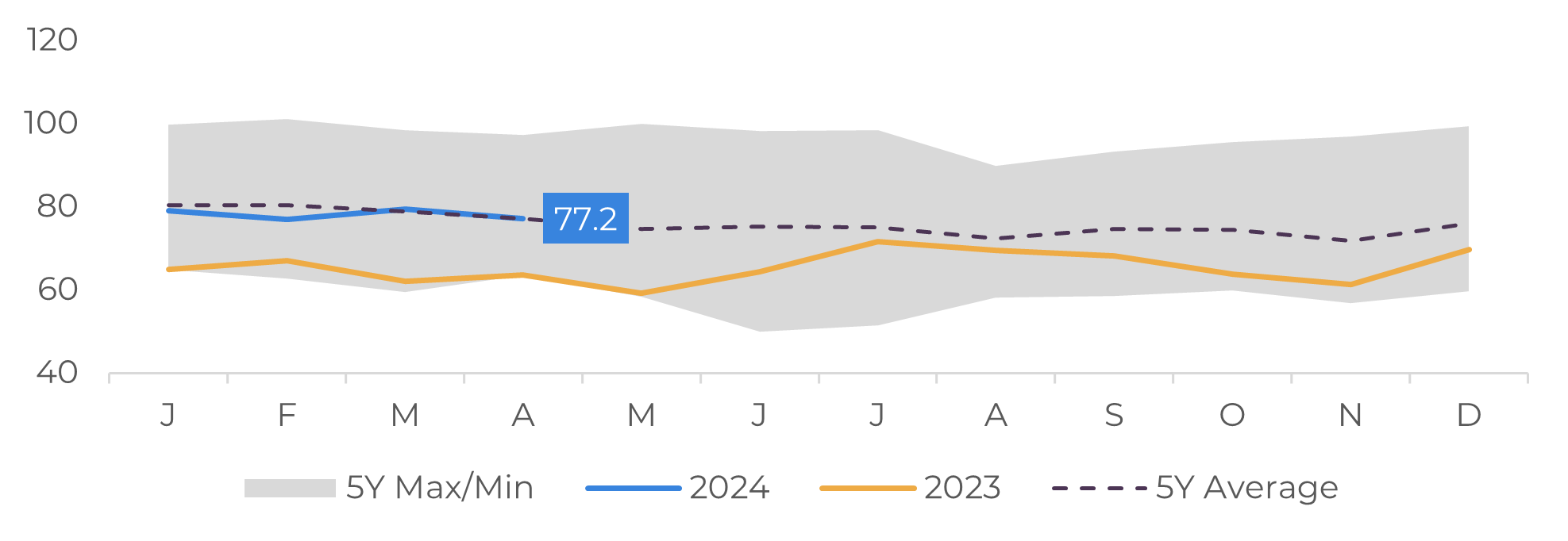
Source: University of Michigan
Image 6: USA - Inflation (PCE)
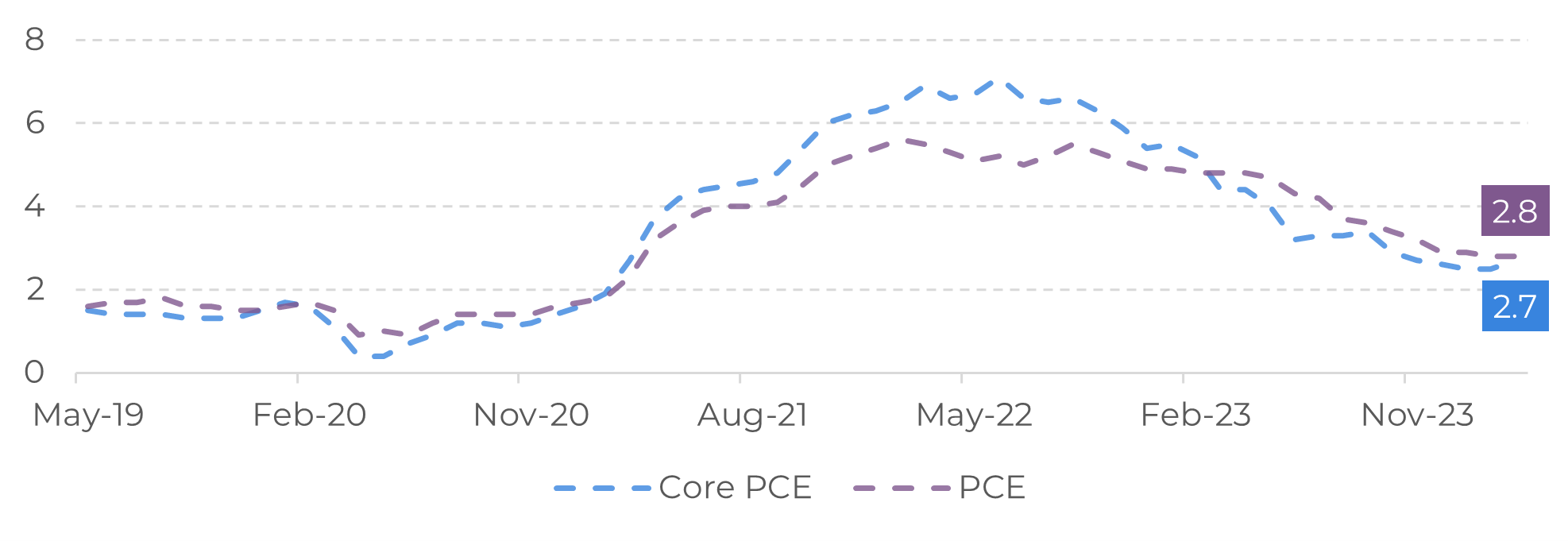
Source: Bureau of Economic Analysis
Weekly Report — Macro
Written by Victor Arduin
victor.arduin@hedgepointglobal.com
victor.arduin@hedgepointglobal.com
Reviewed by Alef Dias
alef.dias@hedgepointglobal.com
alef.dias@hedgepointglobal.com
www.hedgepointglobal.com
Disclaimer
This document has been prepared by Hedgepoint Global Markets LLC and its affiliates (“HPGM”) solely for informational and instructional purposes, without the purpose of instituting obligations or commitments to third parties, nor is it intended to promote an offer, or solicitation of an offer of sale or purchase relating to any securities, commodities interests or investment products. Hedgepoint Commodities LLC (“HPC”), a wholly owned entity of HPGM, is an Introducing Broker and a registered member of the National Futures Association. The trading of commodities interests such as futures, options, and swaps involves substantial risk of loss and may not be suitable for all investors. Past performance is not necessarily indicative of future results. Customers should rely on their own independent judgement and outside advisors before entering in any transaction that are introduced by the firm. HPGM and its associates expressly disclaim any use of the information contained herein that directly or indirectly result in damages or damages of any kind. In case of questions not resolved by the first instance of customer contact (client.services@hedgepointglobal.com), please contact our internal ombudsman channel (ombudsman@hedgepointglobal.com) or 0800-878- 8408/ouvidoria@hedgepointglobal.com (only for customers in Brazil).
Contact us
hedgepointhub.support@hedgepointglobal.com
ouvidoria@hedgepointglobal.com
Funchal Street, 418, 18º floor - Vila Olímpia São Paulo, SP, Brasil
This page has been prepared by Hedgepoint Schweiz AG and its affiliates (“Hedgepoint”) solely for informational and instructional purposes, without the purpose of instituting obligations or commitments to third parties, nor is it intended to promote an offer, or solicitation of an offer of sale or purchase relating to any securities, commodities interests or investment products. Hedgepoint and its associates expressly disclaim any use of the information contained herein that directly or indirectly result in damages or damages of any kind. Information is obtained from sources which we believe to be reliable, but we do not warrant or guarantee the timeliness or accuracy of this information. The trading of commodities interests such as futures, options, and swaps involves substantial risk of loss and may not be suitable for all investors. You should carefully consider wither such trading is suitable for you in light of your financial condition. Past performance is not necessarily indicative of future results. Customers should rely on their own independent judgement and/or advisors before entering in any transaction.Hedgepoint does not provide legal, tax or accounting advice and you are responsible for seeking any such advice separately.Hedgepoint Schweiz AG is organized, incorporated, and existing under the laws of Switzerland, is filiated to ARIF, the Association Romande des Intermédiaires Financiers, which is a FINMA-authorized Self-Regulatory Organization. Hedgepoint Commodities LLC is organized, incorporated, and existing under the laws of the USA, and is authorized and regulated by the Commodity Futures Trading Commission (CFTC) and a member of the National Futures Association (NFA) to act as an Introducing Broker and Commodity Trading Advisor. HedgePoint Global Markets Limited is Regulated by the Dubai Financial Services Authority. The content is directed at Professional Clients and not Retail Clients. Hedgepoint Global Markets PTE. Ltd is organized, incorporated, and existing under the laws of Singapore, exempted from obtaining a financial services license as per the Second Schedule of the Securities and Futures (Licensing and Conduct of Business) Act, by the Monetary Authority of Singapore (MAS). Hedgepoint Global Markets DTVM Ltda. is authorized and regulated in Brazil by the Central Bank of Brazil (BCB) and the Brazilian Securities Commission (CVM). Hedgepoint Serviços Ltda. is organized, incorporated, and existing under the laws of Brazil. Hedgepoint Global Markets S.A. is organized, incorporated, and existing under the laws of Uruguay. In case of questions not resolved by the first instance of customer contact (client.services@Hedgepointglobal.com), please contact internal ombudsman channel (ombudsman@hedgepointglobal.com – global or ouvidoria@hedgepointglobal.com – Brazil only) or call 0800-8788408 (Brazil only).Integrity, ethics, and transparency are values that guide our culture. To further strengthen our practices, Hedgepoint has a whistleblower channel for employees and third-parties by e-mail ethicline@hedgepointglobal.com or forms Ethic Line – Hedgepoint Global Markets.Security note: All contacts with customers and partners are conducted exclusively through our domain @hedgepointglobal.com. Do not accept any information, bills, statements or requests from different domains and pay special attention to any variations in letters or spelling, as they may indicate a fraudulent situation.“HedgePoint” and the “HedgePoint” logo are marks for the exclusive use of HedgePoint and/or its affiliates. Use or reproduction is prohibited, unless expressly authorized by HedgePoint. Furthermore, the use of any other marks in this document has been authorized for identification purposes only. It does not, therefore, imply any rights of HedgePoint in these marks or imply endorsement, association or seal by the owners of these marks with HedgePoint or its affiliates.

